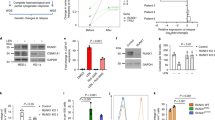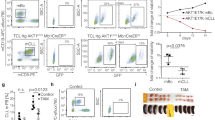Abstract
Myelodysplastic syndromes (MDS) are a group of hematopoietic stem cell disorders characterized by refractory cytopenias and susceptibility to leukemic transformation. On a subset of MDS patients with deletion of the long arm of chromosome5 (del(5q)), lenalidomide exerts hematological and cytogenetic effects, but the underlying pharmacological mechanisms are not fully understood. In this study, we have investigated the in vitro effects of lenalidomide on an MDS-derived cell line, MDS-L, which carries del(5q) and complex chromosome abnormalities. We found that the growth of MDS-L cells was specifically suppressed mainly by apoptosis, and in addition, multinucleated cells were frequently formed and finally died out in the presence of lenalidomide. Time-lapse microscopic observation and the DNA ploidy analysis revealed that lenalidomide does not affect DNA synthesis but inhibits cytokinesis of MDS-L cells. The gene expression profile showed decreased expression of M phase-related genes such as non-muscle myosin heavy-chain 10, polo-like kinase 1, aurora kinase B, citron kinase and kinesin family member 20A(KIF20A). Interestingly, KIF20A is located at 5q31. These data contribute to the understanding of action mechanisms of lenalidomide on MDS with del(5q) and complex abnormalities.
This is a preview of subscription content, access via your institution
Access options
Subscribe to this journal
Receive 12 print issues and online access
$259.00 per year
only $21.58 per issue
Buy this article
- Purchase on Springer Link
- Instant access to full article PDF
Prices may be subject to local taxes which are calculated during checkout






Similar content being viewed by others
References
Heaney ML, Golde DW . Myelodysplasia. N Engl J Med 1999; 340: 1649–1660.
Olney HJ, Le Beau MM . The cytogenetics of myelodysplastic syndromes. Best Pract Res Clin Haematol 2001; 14: 479–495.
Van den Berghe H, Cassiman JJ, David G, Fryns JP, Michaux JL, Sokal G . Distinct haematological disorder with deletion of long arm of no. 5 chromosome. Nature 1974; 251: 437–438.
Brunning RD, Orazi A, Germing U, Le Beau MM, Porwit A, Baumann I et al. Myelodysplastic syndromes. In: Swerdlow SH, et al. (eds). WHO Classification of Tumours of Haematopoietic and Lymphoid Tissues. IARC Press: Lyon, 2008, 87–107.
Boultwood J, Fidler C, Strickson AJ, Watkins F, Gama S, Kearney L et al. Narrowing and genomic annotation of the commonly deleted region of the 5q- syndrome. Blood 2002; 99: 4638–4641.
Giagounidis AA, Germing U, Haase S, Hildebrandt B, Schlegelberger B, Schoch C et al. Clinical, morphological, cytogenetic, and prognostic features of patients with myelodysplastic syndromes and del(5q) including band q31. Leukemia 2004; 18: 113–119.
Pellagatti A, Jädersten M, Forsblom AM, Cattan H, Christensson B, Emanuelsson EK et al. Lenalidomide inhibits the malignant clone and up-regulates the SPARC gene mapping to the commonly deleted region in 5q- syndrome patients. Proc Natl Acad Sci USA 2007; 104: 11406–11411.
Liu TX, Becker MW, Jelinek J, Wu WS, Deng M, Mikhalkevich N et al. Chromosome 5q deletion and epigenetic suppression of the gene encoding alpha-catenin (CTNNA1) in myeloid cell transformation. Nat Med 2007; 13: 78–83.
Joslin JM, Fernald AA, Tennant TR, Davis EM, Kogan SC, Anastasi J et al. Haploinsufficiency of EGR1, a candidate gene in the del(5q), leads to the development of myeloid disorders. Blood 2007; 110: 719–726.
Ebert BL, Pretz J, Bosco J, Chang CY, Tamayo P, Galili N et al. Identification of RPS14 as a 5q- syndrome gene by RNA interference screen. Nature 2008; 451: 335–339.
Wei S, Chen X, Rocha K, Epling-Burnette PK, Djeu JY, Liu Q et al. A critical role for phosphatase haplodeficiency in the selective suppression of deletion 5q MDS by lenalidomide. Proc Natl Acad Sci USA 2009; 106: 12974–12979.
Dredge K, Marriott JB, Macdonald CD, Man HW, Chen R, Muller GW et al. Novel thalidomide analogues display anti-angiogenic activity independently of immunomodulatory effects. Br J Cancer 2002; 87: 1166–1172.
Corral LG, Haslett PA, Muller GW, Chen R, Wong LM, Ocampo CJ et al. Differential cytokine modulation and T cell activation by two distinct classes of thalidomide analogues that are potent inhibitors of TNF-alpha. J Immunol 1999; 163: 380–386.
Schafer PH, Gandhi AK, Loveland MA, Chen RS, Man HW et al. Schnetkamp PPEnhancement of cytokine production and AP-1 transcriptional activity in T cells by thalidomide-related immunomodulatory drugs. J Pharmacol Exp Ther 2003; 305: 1222–1232.
Davies FE, Raje N, Hideshima T, Lentzsch S, Young G, Tai YT et al. Thalidomide and immunomodulatory derivatives augment natural killer cell cytotoxicity in multiple myeloma. Blood 2001; 98: 210–216.
Muller GW, Chen R, Huang SY, Corral LG, Wong LM, Patterson RT et al. Amino-substituted thalidomide analogs: potent inhibitors of TNF-alpha production. Bioorg Med Chem Lett 1999; 9: 1625–1630.
List A, Dewald G, Bennett J, Giagounidis A, Raza A, Feldman E et al. Lenalidomide in the myelodysplastic syndrome with chromosome 5q deletion. N Engl J Med 2006; 355: 1456–1465.
Gandhi AK, Kang J, Naziruddin S, Parton A, Schafer PH, Stirling DI . Lenalidomide inhibits proliferation of Namalwa CSN.70 cells and interferes with Gab1 phosphorylation and adaptor protein complex assembly. Leuk Res 2006; 30: 849–858.
Hideshima T, Chauhan D, Shima Y, Raje N, Davies FE, Tai YT et al. Thalidomide and its analogs overcome drug resistance of human multiple myeloma cells to conventional therapy. Blood 2000; 96: 2943–2950.
Nakamura S, Ohnishi K, Yoshida H, Shinjo K, Takeshita A, Tohyama K et al. Retrovirus-mediated gene transfer of granulocyte colony-stimulating factor receptor (G-CSFR) cDNA into MDS cells and induction of their differentiation by G-CSF. Cytokines Cell Mol Ther 2000; 6: 61–70.
Tohyama K, Tsutani H, Ueda T, Nakamura T, Yoshida Y . Establishment and characterization of a novel myeloid cell line from the bone marrow of a patient with the myelodysplastic syndrome. Brit J Haematol 1994; 87: 235–242.
Drexler HG, Dirks WG, Macleod RA . Many are called MDS cell lines: one is chosen. Leuk Res 2009; 33: 1011–1016.
Bonnet J, Coopman P, Morris MC . Characterization of centrosomal localization and dynamics of Cdc25C phosphatase in mitosis. Cell Cycle 2008; 7: 1991–1998.
Tsujioka T, Tochigi A, Kishimoto M, Kondo T, Tasaka T, Wada H et al. DNA ploidy and cell cycle analyses in the bone marrow cells of patients with megaloblastic anemia using laser scanning cytometry. Cytometry B Clin Cytometry 2008; 74: 104–109.
Shi Y, Tohyama Y, Kadono T, He J, Shahjahan Miah SM, Hazama R et al. Protein–tyrosine kinase Syk is required for pathogen engulfment in complement-mediated phagocytosis. Blood 2006; 107: 4554–4562.
Nigg EA . Origins and consequences of centrosome aberrations in human cancers. Int J Cancer 2006; 119: 2717–2723.
Glotzer M . The molecular requirements for cytokinesis. Science 2005; 307: 1735–1739.
Guse A, Mishima M, Glotzer M . Phosphorylation of ZEN-4/MKLP1 by aurora B regulates completion of cytokinesis. Curr Biol 2005; 15: 778–786.
Echard A, Jollivet F, Martinez O, Lacapère JJ, Rousselet A, Janoueix-Lerosey I et al. Interaction of a Golgi-associated kinesin-like protein with Rab6. Science 1998; 279: 580–585.
Fontijn RD, Goud B, Echard A, Jollivet F, van Marle J, Pannekoek H et al. The human kinesin-like protein RB6K is under tight cell cycle control and is essential for cytokinesis. Mol Cell Biol 2001; 21: 2944–2955.
Gruneberg U, Neef R, Honda R, Nigg EA, Barr FA . Relocation of Aurora B from centromeres to the central spindle at the metaphase to anaphase transition requires MKlp2. J Cell Biol 2004; 166: 167–172.
Kaiser BK, Zimmerman ZA, Charbonneau H, Jackson PK . Disruption of centrosome structure, chromosome segregation, and cytokinesis by misexpression of human Cdc14A phosphatase. Mol Biol Cell 2002; 13: 2289–2300.
Ganem NJ, Pellman D . Limiting the proliferation of polyploid cells. Cell 2007; 131: 437–440.
Andreassen PR, Lohez OD, Lacroix FB, Margolis RL . Tetraploid state induces p53-dependent arrest of nontransformed mammalian cells in G1. Mol Biol Cell 2001; 12: 1315–1328.
Giagounidis AAN, Germing U, Strupp C, Hildebrandt B, Heinsch M, Aul C . Prognosis of patients with del(5q) MDS and complex karyotype and the possible role of lenalidomide in this patient subgroup. Ann Hematol 2005; 84: 569–571.
Tasaka T, Tohyama K, Kishimoto M, Ohyashiki K, Mitani K, Hotta T et al. Myelodysplastic syndrome (MDS) with chromosome 5 abnormalities: a nation-wide survey in Japan. Leukemia 2008; 22: 1874–1881.
Kantarjian H, O’Brien S, Ravandi F, Borthakur G, Faderl S, Bueso-Ramos C et al. The heterogeneous prognosis of patients with myelodysplastic syndrome and chromosome 5 abnormalities: how does it relate to the original lenalidomide experience in MDS? Cancer 2009; 115: 5202–5209.
Haferlach C, Bacher U, Tiu R, Maciejewski JP, List A . Myelodysplastic syndromes with del(5q): indications and strategies for cytogenetic testing. Cancer Genet Cytogenet 2008; 187: 101–111.
Raza A, Reeves JA, Feldman EJ, Dewald GW, Bennett JM, Deeg HJ . Phase 2 study of lenalidomide in transfusion-dependent, low-risk, and intermediate-1 risk myelodysplastic syndromes with karyotypes other than deletion 5q. Blood 2008; 111: 86–93.
Acknowledgements
We thank Ms. Kazuko Yamane (Kawasaki Medical School) for her technical support.
This study was supported in part by the grant of the Japanese Cooperative Study Group for Intractable Bone Marrow Diseases, Ministry of Health, Labor and Welfare of Japan; in part by a Grant-in-Aid for Scientific Research from Japan Society for the Promotion of Science; and in part by Kawasaki Medical School Project Grant.
Author information
Authors and Affiliations
Corresponding author
Ethics declarations
Competing interests
K.T. has received research funding from Celgene K.K. The other authors declare no competing financial interests.
Additional information
Authorship Contributions: K.T. designed the research and wrote the paper; A.M., A.T., T. N., T.K., and T.Ts. performed the experiments; M.K. performed statistical analyses; T.Ta. and Y.T. analyzed the results and contributed to useful discussion.
Supplementary Information accompanies the paper on the Leukemia website
Supplementary information
Rights and permissions
About this article
Cite this article
Matsuoka, A., Tochigi, A., Kishimoto, M. et al. Lenalidomide induces cell death in an MDS-derived cell line with deletion of chromosome 5q by inhibition of cytokinesis. Leukemia 24, 748–755 (2010). https://doi.org/10.1038/leu.2009.296
Received:
Revised:
Accepted:
Published:
Issue Date:
DOI: https://doi.org/10.1038/leu.2009.296
Keywords
This article is cited by
-
The evolution of preclinical models for myelodysplastic neoplasms
Leukemia (2024)
-
Clonal hematopoiesis in adult pure red cell aplasia
Scientific Reports (2021)
-
Inhibition of CBP synergizes with the RNA-dependent mechanisms of Azacitidine by limiting protein synthesis
Nature Communications (2021)
-
Menatetrenone facilitates hematopoietic cell generation in a manner that is dependent on human bone marrow mesenchymal stromal/stem cells
International Journal of Hematology (2020)
-
Binimetinib, a novel MEK1/2 inhibitor, exerts anti-leukemic effects under inactive status of PI3Kinase/Akt pathway
International Journal of Hematology (2019)



